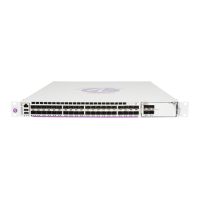Filter Policies
7705 SAR OS Router Configuration Guide 277
Policy-Based Routing
Traditionally, IP routing is done by making routing decisions based on the destination IP
address of the incoming packet. PBR expands the routing decision from one based solely on
the destination IP address to include any other IP criteria, such as source IP address, DSCP,
or source/destination UDP/TCP port.
Using PBR at the ILER node provides filtering needed to route IP traffic over multiple uplink
interfaces or tunnels using IP criteria. For example, a service provider can use PBR to
separate high-value traffic (signaling) from user data by examining the source IP address
and/or DSCP bits of the incoming IP packets, and assign a separate transport tunnel to each
traffic flow. The transport tunnels could be engineered by using RSVP-TE throughout the
entire mobile backhaul network with specific reservation values. The LSP is signaled
throughout the network and reserves the needed resources at each node, ensuring the QoS for
the high-value traffic.
PBR can also be used to extract packets from the data path and send them to the CSM for
debugging or slow path forwarding.
Figure 9 illustrates a PBR implementation for VPRN services in an LTE network, and
includes CLI command syntax. The 7705 SAR-8 at the cell site makes routing decisions
based on the incoming packet DSCP only, as follows:
• BE packets are forwarded to 7750 SR_1 over SDP1
• AF11 packets are forwarded to 7750 SR_2 over SDP2
• each SDP (SDP1 and SDP2) is signaled throughout the network using RSVP-TE
protocol with its own separate TE criteria

